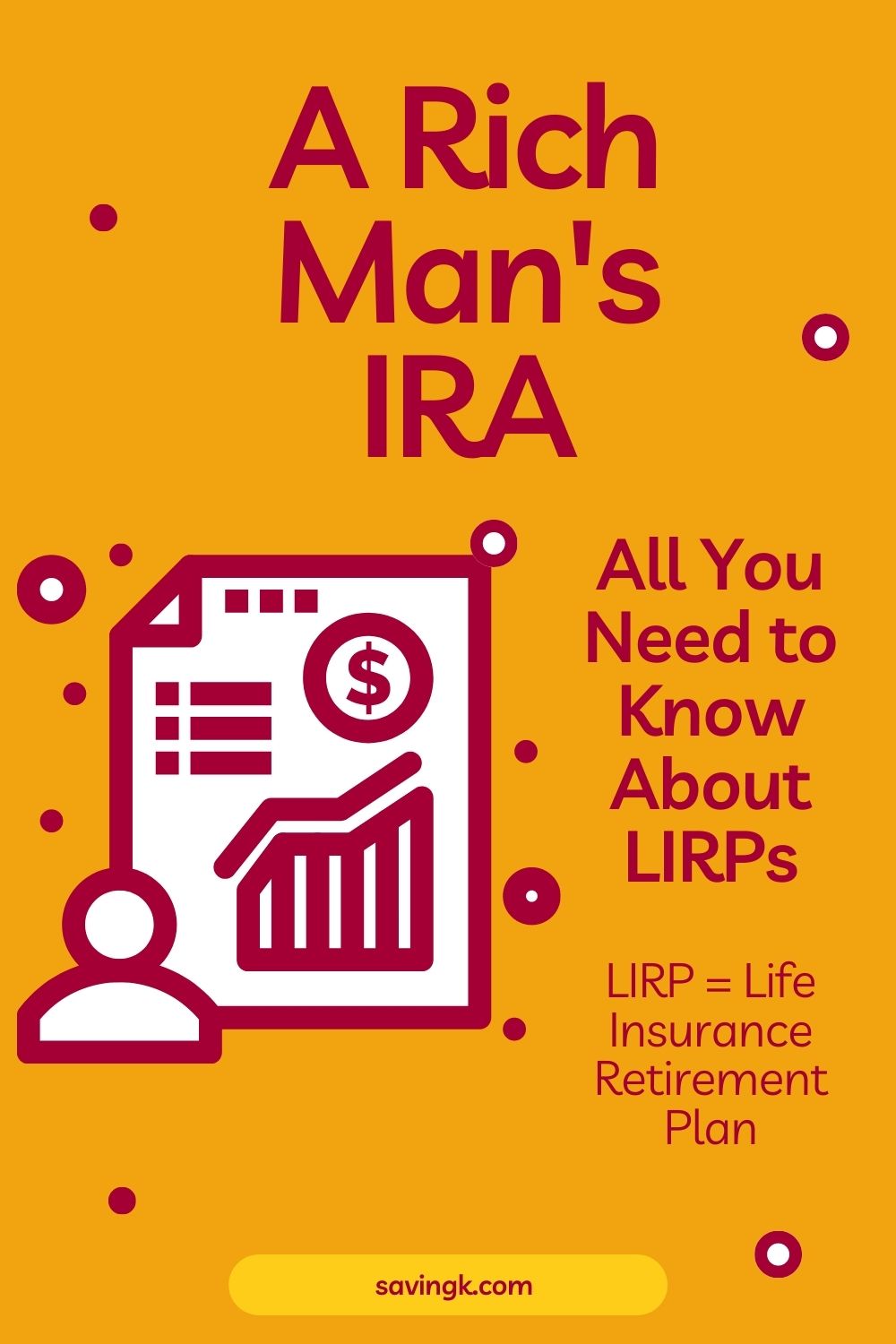
In 2020, when I sold some of my website properties (details here), my Edward Jones advisor recommended that I set up a “rich man’s IRA” to which I looked at him dumbfounded asking what that was. He explained that many affluent people invest in LIRPs. LIRP stands for Life Insurance Retirement Plan.
What’s about a rich woman’s IRA?!? 🙂
Contents
What is a LIRP?
A LIRP is a life insurance policy that has an investment component. The cash value of the life insurance policy grows tax-deferred, and you can use it for things like supplementing your retirement income, paying for long-term care, or leaving a legacy.
This type of permanent life insurance incorporates several of the Roth IRA’s tax-free features. Large, tax-free income streams can be provided by a properly financed LIRP to policyholders during their retirement years. It can sound desirable to have life insurance and retirement funds together. The funds’ earnings amass without being taxed. Additionally, you are not subject to the same penalties for borrowing against the accumulated value as you might be for other retirement plans.. You can choose not to repay the borrowed money, in which case it will just be taken (together with interest) from the amount of your death benefit payment. These fantastic qualities help to explain why this kind of life insurance is so well-liked.
The Pros and Cons of LIRPS
LIRPs, or life insurance retirement plans, are one type of investment that some people use to help save for retirement. Here we will take a look at some of the pros and cons of investing in a LIRP, and it’s important to understand them before making a decision about whether or not to invest in one.
The Pros of LIRPs
Here are the several benefits of a LIRP.
Tax Advantages
LIRPs offer tax advantages that other types of retirement plans don’t. One of the biggest advantages of a LIRP is that the money invested grows tax-deferred. This means that you will not have to pay taxes on the money until you actually withdraw it, and since most people’s tax rates are lower in retirement than during their working years, this can save you a significant amount of money.
Since the cash value of a LIRP grows tax-deferred, this is a big pro. With a LIRP, you can grow your money without having to pay taxes on the growth until you withdraw the money. This allows your money to compound faster than it would if it were in a taxable account. This can be a big advantage, because it allows the cash value to grow more quickly..
Guaranteed Investment
A LIRP guarantees that your investment returns will not be lower than the floor. This means that you can sit back and relax, knowing that there will never be a year in your life where you’ll lose money. It is a guaranteed investment, which means that one will never incur a loss in any year and he/she will get a return no matter the market situation.
LIRPs provide guarantees and safety. Depending on your product choice and allocation, having a LIRP provides you with guaranteed returns and protection from incurring financial losses.
Unlike some investments, with a LIRP, you know exactly how much money you will have at retirement (assuming you don’t make any withdrawals before then). This predictability can be helpful in planning for retirement expenses.
Your money is invested in conservatively-rated bonds, which helps reduce the risk of losing money during bad economic times. There is no loss of value if or when the stock market declines.
Death Benefits
Another advantage of LIRPs is that they can provide a death benefit for your beneficiaries. If you die before you have withdrawn all of the money in your account, your beneficiaries will receive the full death benefit, which can be used to help them cover expenses.
Since a LIRP also has a death benefit, this means that your loved ones will receive a lump sum of cash if you die while the policy is in force. This allows your beneficiary to receive the maximum death benefit possible.
If something happens to you and you haven’t yet retired, your loved ones will receive the death benefit from your policy – something they wouldn’t get if you had retired and cashed in your policy prematurely.
Retirement Benefits
One of the big advantages of a LIRP is that you can use the cash value for things like supplementing your retirement income. If you have a LIRP with a good cash value, you can use it to supplement your income in retirement. This can be a big help in meeting your financial goals in retirement.
LIRPs can be a good way to save for retirement, as they offer a variety of investment options as the money you receive from your LIRP is guaranteed income for life, which can be very reassuring during retirement. Many LIRPs offer lifetime income payments, which can provide you with a steady stream of income during retirement.
Unlike some other types of retirement plans, there are no required distributions from a LIRP, which means you can keep your money invested for as long as you want.
Unlike a 401(k), a LIRP would not require you to pay a penalty if you decide to take money out of it. A LIRP is a better investment than a 401(k) if you’re looking to retire before age 59 ½ because you won’t be charged a 10% penalty for accessing funds.
You can also use the cash value of your policy to pay for long-term care. If you need to pay for long-term care, you can use the cash value of your life insurance policy to help pay for it. This can be a big help in meeting your long-term care needs.
Borrow Options
Through a LIRP, one can get a regular tax-free income stream or borrow against the value of the plan. This means you can borrow against your policy’s cash value if you need extra money during retirement.
A LIRP can provide you with an opportunity to fund your own business without having to rely on bank loans. One could easily get a loan for a startup if they are a participant in a life insurance retirement plan. Loans through LIRP are less restricted and can be adjustable according to one’s needs.
Please note that if you need to take a loan from the cash value of your life insurance policy, you will have to pay interest on the loan. This can reduce the amount of money that you have available to leave to your beneficiaries.
Flexibility
Many LIRPs offer flexibility in how and when you can take distributions from your plan. This can be helpful in retirement planning, as it allows you to tailor your withdrawals to fit your needs and desired lifestyle.
The Cons of LIRPs
There are some disadvantages of LIRPs to take into consideration.
Health Examination
Since a LIRP is life insurance, you will need to have a health examination and pass to qualify. A nurse came to my house to check my height and weight, check my blood pressure and took a blood sample (just a prick on the finger).
The underwriters will also want to know what medications you take and ask high-risk questions, such as “have you ever jumped out of an airplane?” I answered yes to riding in a hot air balloon which raised a red flag!
Complexity
Some LIRPs can be complex, and they may not be suitable for everyone. If you are not comfortable with risking your money in an investment that you do not fully understand, then a LIRP may not be right for you.
And since LIRPs can be complex products, it may be difficult to find an advisor who is knowledgeable about them.
Expensive Premium
LIRPs can be expensive because the premium you’ll be paying will depend on factors like your health status, age, number of dependents, income level, and the type of product you’ll be getting. My yearly premium is $20,000.
If you can’t pay the agreed amount monthly or annually it can lead to the cancellation of LIRP.
Slower Growth
LIRPs are slow to grow- the average return rate for LIRPs ranges from 5% to 8% per year for a portfolio that’s 60% invested in stocks and 40% invested in bonds.
The LIRP principle amount may grow too slowly as compared to other options available in the market. LIRPs often offer much fewer investment options, meaning you’ll potentially miss out on opportunities to grow your retirement wealth versus other types of plans.
Death Benefits Taxable
The death benefit from a LIRP is typically taxable, which means your beneficiaries may not receive as much money as they would with a traditional life insurance policy. When you die, your beneficiaries will receive the death benefit from your life insurance policy. If the death benefit is more than the cost of the policy, your beneficiaries may have to pay taxes on the difference.
High Fees
One potential downside of LIRPs is that they typically have high fees and commissions associated with them. This can eat into your investment returns and leave you with less money than you would have if you had invested in a different type of retirement account.
These fees can include things like the insurance company’s administrative fees, investment management fees, and other charges. Be sure to understand the fees before you purchase a LIRP.
There are usually surrender charges if you cash in your policy early, making it difficult to access your money if you need it before retirement.
Pros & Cons Review
As with any investment, there are pros and cons to consider before investing in a LIRP. Be sure to do your research and speak with a financial advisor to determine if a LIRP is right for you and your unique circumstances.
Personal LIRP Testimony
Below is a review from Jared Weitz, CEO/Founder of United Capital Source Inc. who personally has a LIRP. Hearing from someone (besides me) that has a LIRP may help with your decision on whether to invest in one or not.
I have a LIRP. One of the main appeals of a LIRP is that you can ensure your family gets a payout if you pass away. The monthly premium is a small price to pay to ensure the financial security of my family. Another plus is that you can contribute to your LIRP even if you’ve maxed out your 401(k) or IRA contributions. This is especially helpful if you need to beef up your retirement savings beyond the preset contribution limits. However, LIRPs aren’t all sunshine and rainbows. LIRPs typically have a lower return on investment, so if you’re looking to maximize your profits at the expense of safety, other investment options may be better. Additionally, contributions to a LIRP are not tax-deductible, unlike other retirement investments such as an IRA. All in all, I would recommend investing in a LIRP if you’ve already maxed out your other retirement options.
Professional LIRP Testimony
Levon L. Galstyan, Certified Public Accountant at Oak View Law Group, weighed in on his professional experience with LIRPs.
In today’s day and age, many people prefer to invest in LIRPs. I like it because of the tax implications, but there are other benefits.
LIRPs were popular among my clients. Some weren’t thrilled with it, but the vast majority were.
If properly structured, LIRPs can provide tax-free income in retirement through policy loans while protecting you from potential income tax increases. This is, in my opinion, one of the best features of LIRP and one of the main reasons that most of my clients invested in it.
Taxes are never exciting to pay, especially when they threaten your long-term investments. With a LIRP, you can be less concerned about financial market volatility and tax rate uncertainty. This tool can give you extra peace of mind that your family will inherit a tax-advantaged legacy when you die.
Some of my clients were tired of dealing with Roth IRAs, where the IRA imposes income limits on who can contribute and how much they can contribute. Because there is no such concern with LIRPs, it has proven to be an excellent investment option for them.
One of my clients who invested in LIRPs benefited from it when he became very ill because it covers terminal, critical, and chronic illnesses. He also used the borrowing facility once when he was in financial trouble.
He initially wanted to withdraw money from his LIRP, but it wasn’t tax-free. I was aware of LIRP’s tax-free feature, which allows you to borrow money from your gains, and I advised him to take advantage of it.
Although tax-free, he had to pay interest because it was technically a loan. But it was still a win for him because he received interest from his LIRP, making it a 0% wash loan. Basically, he got back what he paid.
Overall, there are numerous advantages to making this investment. However, as I previously stated, not all of my clients had a positive experience with this investment.
One of my clients, who is also a good friend, also invested in LIRP. The only mistake he made was that he did not consider the future and most likely needed to conduct adequate research.
Permanent life insurance policies, such as LIRPs, are typically more expensive than term policies. I advised him to refrain from investing in LIRPs because he was not financially stable, but he did.
The most unfortunate thing happened to him when he couldn’t keep up with the premiums. He had no idea that his policy would collapse if he didn’t make the payments on time. This happened when he started a family and could not keep up with the premiums due to the increased expenses.
I don’t blame the investment for this unfortunate event because everyone should conduct proper research and planning before investing, which my client clearly did not.
If you want to invest in LIRPs or any other investment, make sure you do your homework first. Overall, I believe that LIRP is a good investment as it provides a lot of benefits and the cons of it can easily be avoided with proper planning and research.
Conclusion
LIRPs are essentially life insurance plans with some extra perks that can help you manage your finances in retirement. They should definitely not be used in place of an actual retirement plan, and their primary function is still to pay out benefits to your survivors and beneficiaries when you die. That being said, they offer a number of tax-free options to use these plans as sources of money. An overfund cash value option will allow you to withdraw money from your life insurance plan if you’ve put more into it than the defined benefit. This allows you to work around taxes and have a safe place to put your money where it will appreciate. You can also borrow against the value of your life insurance benefit, or even withdraw it early if you’re dealing with certain specific financial hardships.
Before you decide to invest in a LIRP, be sure to talk to a financial advisor to see if it is the right retirement account for you.

LIRP Source Credit
I rounded up help with writing this article. The following people have also contributed to this article by giving me either their definitions, thoughts, opinions, and/or pros and cons of LIRPs:
- Andy Kalmon, CEO of Benny
- Carter Seuthe, CEO of Credit Summit
- Cole South, Co-Founder of Synchronize
- Emam Zaman, Director of Marketing of ViVipins
- Imran Ali, Co-Founder of Glasses Hut
- Jake Hill, CEO of DebtHammer
- Linda Chavez, Founder & CEO of Seniors Life Insurance Finder
- Mo Mulla, Founder of Parental Questions
- Shaun Martin, Real Estate Investor with We Buy Houses in Denver
- Stacy Lewis, Owner of Eternity Modern
- Praying To Saint Anthony For Lost Items - February 6, 2025
- How To File Your 2024 Income Taxes Online For Free In 2025 - January 20, 2025
- How To Win Sweepstakes and Contests - December 7, 2024




